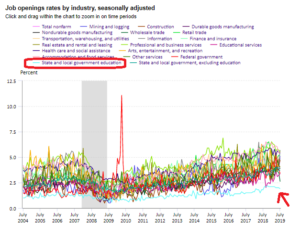Bellwether has a cool new micro-site on rural charter schools. It profiles four successful rural charter schools that are outperforming state and local averages while serving students who are economically diverse. Check out RuralCharterSchools.org and then read Kelly Robson on what drives their success.
These are some impressive growth trends in AP Computer Science test-taking among females and underrepresented minorities.
EdNavigator reminds us that school closures can be disruptive, but there are also things schools and districts can do to make that transition as successful as possible. With supports in place in New Orleans, “93 percent of students from closing schools with D-F letter grades landed in a new school that was at least one letter grade better, and 66 percent gained seats in a school two letter grades better.”
The Washington Post has a big new piece out today about how our schools are diversifying. Yes, diversifying, you read that correctly. I think this runs counter to the conventional narrative, but they find that, “In 2017, 10.8 million children attended highly integrated public schools, up from 5.9 million in 1995, an 83 percent increase that stems largely from rising diversity outside metropolitan areas.” This over a period when total student enrollment rose just 6 percent. The WaPo also created a handy tool to look up your district.
This new study on Chicago’s selective high schools may surprise some people, particularly the finding that winning a spot at a selective high school may harm disadvantaged students, because it means those students won’t go to a charter school run by the Noble network. The “control” group attending the open-enrollment Noble charters outperformed the “treatment” of going to the selective exam schools.
The latest Job Openings and Labor Turnover Survey (JOLTS) data from the BLS are out. The topline finding is that job openings and quit rates are rising across the entire American economy. This is true for education as well, but keep in mind that public K-12 education consistently has lower turnover rates than other sectors in our economy. I’ve circled and added an arrow to the light blue line in the BLS graph comparing industries over time (click on the image to see it larger): 
Tucked into this Washington Post piece on the changing demographics of new hires is an interesting stat on apprenticeships: “Companies and labor unions have also stepped up their outreach to minorities and have their own training programs. Labor Department figures show employers started 3,229 new apprenticeship programs last year — almost double the rate in 2016. Part of the jump may be due to companies feeling the need to grow talent from within and the Trump administration’s push to formally register apprenticeship programs.”
Sue Dynarski argues that taking out a student loan is better than dropping out of college. She writes, “Fully half of community colleges never offer loans…apparently because the schools are concerned that students will get themselves into financial trouble…. But the new evidence strongly suggests that such policies are harming students. Loans provide critical funds for paying tuition, meeting living expenses and buying school supplies. Discouraging students from taking out loans — without providing financial alternatives — harms their ability to progress through college.”
Don’t miss Kris Amundson on how Virginia can support first-generation students applying to college.
A randomized control trial of early college high schools found strong results, according to a new AIR study. Participating students had college completion rates about 12 percent points higher than the control group and, critically, they also earned those credentials earlier, giving participants a headstart into the workforce.
Who knew there was an actual scientific why reason school buses are yellow?
Agnes Callard writes a defense of playing the devil’s advocate… and when and how to do it well.
–Guest post by Chad Aldeman
